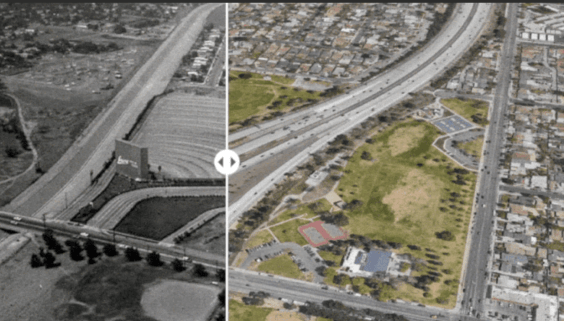 A simulation of the proposed discount mall on Market Street, City Place. Image: Urban Realty.
A simulation of the proposed discount mall on Market Street, City Place. Image: Urban Realty.At another marathon Planning Commission meeting last week, parking was all the rage. Two projects in particular had community members and housing and transit advocates fired up because of the parking that developers proposed to build, or in one case, to not build.
As we reported a year and a half ago when Streetsblog just started in San Francisco, neighborhood residents and advocates were upset that 299 Valencia Street, the first project to be approved in the Market and Octavia Plan area, was allowed to move forward with parking in excess of the plan's standard. At the time they argued it would set a precedent, while Supervisor Bevan Dufty and members of the Board of Supervisors supporting it said that wouldn't be the case.
A year and a half later, project sponsors continue to push the envelope with parking and advocates worry nothing has changed since 299 Valencia.
A number of community groups and advocates see the Planning Department
and the Planning Commission as failing to uphold the spirit and letter of
neighborhood plans by permitting variances and conditional uses to grant
parking in excess of the limits in the plans. Some would go so far as
to say planning in San Francisco is marked more by the exceptions to plans than the plans themselves.
The project that most rankled advocates was a discount merchandise mall called City Place on Market Street between 5th and 6th Streets, which was approved with a great deal more parking than would have been allowed under code, but somewhat less than the project sponsors had originally wanted, and much less parking than equivalent projects in other dense urban environments.
City Place will be a five-story, 250,000 square feet glass structure fronting mid-Market Street with a rear entrance on Stevenson Street and two levels of underground parking, or 167 spaces, 97 more spaces than the Downtown Plan would allow of right. Urban Realty, the developers, had initially sought three levels and over 200 spaces, but brought those numbers down through negotiations with Planning Department staff and advocates like Livable City, Walk SF, and the San Francisco Bicycle Coalition. They also added secure bike parking and eight car-share spaces, which earned a letter of support from City CarShare.
 City Place facade image: Urban Realty.
City Place facade image: Urban Realty.Compared to similar projects in other cities, like the Atlantic Center in Brooklyn, New York, City Place would have less parking relative to square footage, which developer David Rhoades and his team were quick to highlight. Rhoades also pointed to a pioneering effort to incorporate bicycle delivery
"When we began the entitlement process for this project five years ago, we had a vision for this project. It was to bring something to this stretch of Market Street that would really activate the street, that would bring much needed foot traffic," said Rhoades. The project sponsors also estimated up to seventy percent of customers would arrive by some mode other than private vehicles.
It's exactly why Tom Radulovich of Livable City lamented the additional parking spaces and the many short-term trips that could add to traffic and conflict with pedestrians and transit vehicles, the very customers that make up the majority of those expected to visit the mall. Radulovich was even more concerned the EIR hadn't proposed significant mitigations to these pedestrian impacts, nor had the department heeded its own short-term parking policy (20.7), which requires converting existing nearby long-term parking to short-term parking before adding more.
"The deck is stacked against livability, stacked against bicycling, walking," said Radulovich. The policy about short-term parking, the crux of the debate, he said, "was ignored by the Planning Department."
Radulovich pointed to the EIR, which showed 1500 parking spaces within walking distance of the new facility, not to mention the more than 2800 spaces two blocks away at the 5th and Mission Garage.
Radulovich said this was a litmus test for the Downtown Plan and feared it would set a precedent for future developers to demand similar concessions to City Place, especially along Market Street, and extending farther from the 5th and Mission garage.
Planning Commissioner Gwyneth Borden disagreed with the assertion that approval would set a precedent for other developers and said many other factors were at stake in addition to parking. She said there were no city plans for revitalizing mid-Market Street on the near horizon, so they were relying on the private market to help. Without the parking spaces, she was concerned the developer wouldn't have attracted tenants.
"We don't at all see this as a litmus test. This is a specific project
with specific benefits and we conferred that opportunity for that
specific project," said Borden. "We were clear to say this wasn't a precedent. This was not a statement
about parking on future blocks. We have no intention of adding parking all along the downtown core. That
is not our intention."
Borden said the support of the Tenderloin Housing Clinic and the Tenderloin Neighborhood Development Corporation were significant deciding factors (Commissioner Christina Olague said the same thing at the meeting). Borden also pointed to the innovations the developer would explore, including the bicycle delivery, the various car-share spaces and a project to provide incentives to micro-entrepreneurs along a new space on Stevenson Street at the back of the mall.
"Quite frankly, for that kind of development, 167 spaces is not a lot.
It's over-parked for the Downtown Plan, but it's under-parked for this
type of development."
Planning Director John Rahaim also argued no precedent was being set with the approval and said additional parking in this instance didn't violate the spirit of the Downtown Plan. Rahaim said in rough terms San Francisco adds large retail like this project once a decade and if another project comes along ten years from now, the developers would be hard-pressed to argue City Place as a precedent.
"We've had a very strong
history of sticking to the maximum on other uses," he said, noting the benefits of revitalization the project could have for the area. "I do believe a certain modest percentage of parking is not
inappropriate. That's a trade-off, I think."
1050 Valencia Street: The Case for No Parking
 Current use of 1050 Valencia. Photo: Shizuo Holding Trust.
Current use of 1050 Valencia. Photo: Shizuo Holding Trust.On a completely different tack, a developer recently proposed a building along the neighborhood commercial district of Valencia Street in the
Mission that led to vociferous community complaint at the Planning Commission, though for the opposite reason: too little parking.
Shizuo Holding Trust received permission to proceed with a five story, 16-unit rental apartment building on Valencia Street at the corner of Hill Street, where Spork restaurant is currently located, but neighbors filed an appeal of the mitigated negative declaration, saying the project was out of character with the historic Liberty Hill District and the lack of parking would make it even more difficult to find a spot.
One of the neighbors, Peter Heinicke, said parking was only one facet of their opposition (historic character, bulk, and the proposed roof deck were other issues), but it was a significant concern.
"I think if you knew that everybody who moved in there was going to bike all the time and wouldn't own a car, that obviously would be a lot less of an impact," said Heinicke. "Despite it in theory being a transit rich neighborhood, the fact is the Muni service is so bad, we're really not a transit-rich neighborhood."
"The effect is I think someone who lives there is likely going to have a car. They may not drive it all the time, but they're going to need to have it and they're going to need to park it somewhere, even if they take BART into work," he added. "We'd like to see something maybe a little more balanced on that aspect of it."
Planning Commissioners agreed with the neighbors' contention that the EIR for the project had failed to adequately address the historic impacts to the Liberty Hill District. The matter was continued until September 2nd, when the project sponsor and Planning staff will return with the completed EIR.
Jason Henderson, a member of the Hayes Valley Neighborhood Association and one of the advocates for the Market and Octavia Neighborhood Plan, said the opposition to a "good project" with no parking along a bicycle route was disheartening. It was even more troubling to him that they would be given more time to organize opposition to 1050 Valencia over the next couple months.
Their argument, he said, is "based on the assumption that everyone is going to have a car or you have to have a car. It's not empirically driven."
"What they are saying is they live on a hill and they have to drive and everyone else has to drive too," he said. "They're presenting it from their view living on a hill with expensive Victorian houses."
Planning's Rahaim also lamented the delay to the project, saying he was impressed the developer had come forward with no parking in the plans.
"I'm pleasantly surprised to have that project come forward as a model," he said. "The common wisdom is that lenders won't come forward to sponsor no parking. I'm really hoping this one goes through from a financing perspective."
Commissioner Borden said she was also unhappy to delay it until September, though she noted the EIR was incomplete from the historic impact perspective.
"The project needs to adequately address the transition between the new and the old," she said. "The project has to be sensitive to celebrating the historic district and being a part of it, not standing out from it."
Of the proposal not to add parking, she said: "It's great, it doesn't need to have parking. A lot of these old buildings in San Francisco didn't have parking. I hope that they are successful."






